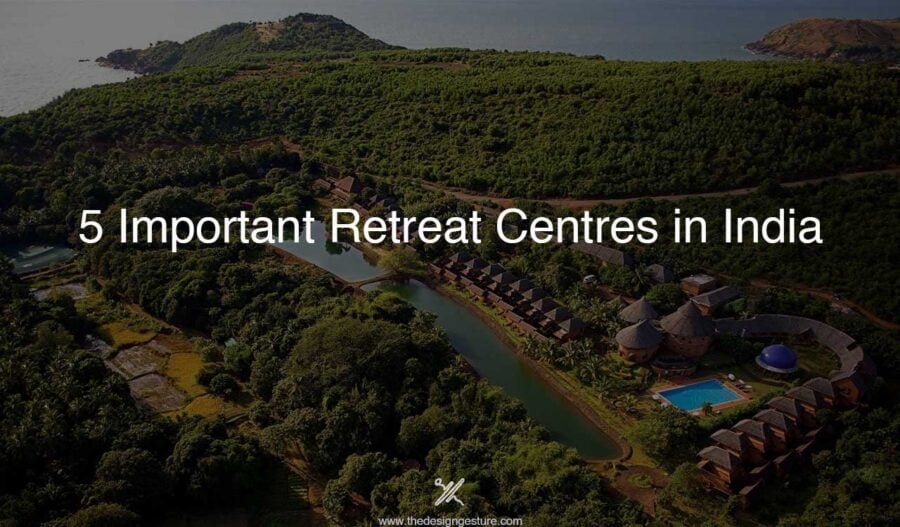“The life of inner peace, being harmonious and without stress, is the easiest type of existence.”
—Norman Vincent Peale
People often attempt to make their inner selves happy. It is unusual to think that their lives should be meaningful as they are afraid of meaninglessness. People fret about the ‘nihilism’ of this or that aspect of our culture. It is important to communicate and be satisfied with the idea of living. The saying, “If you can’t go outside, go inside” refers to the idea that everything will settle down if you awaken your inner self.
Humans can take care of minds and souls by practising meditation. But with all the hustle of the external environment, it is difficult to meditate. For this purpose, Retreat Centres were designed to cultivate an environment that disconnects humans from the external world.
Table of Contents
Introduction
The concept and understanding of retreat is not a linear one, as the meaning is subjective and has transformed & continues to shift, and reflects present societal issues and many needs as to how much and in which way one retreats. A basic and common understanding is that retreats provide “a sense of respite, refuge and rest, and this often forms the essence of this type of wellness tourism provision (Kelly, 2010:109)
In today’s world, People have undergone wonderful experiences emotionally, spiritually and physically in these Retreat Centres. As the growing demand for work and labour increases, the human race is becoming hectic each day, they further feel a need to rejuvenate and regain good health.
What are Retreat Centres?
A retreat centre can serve various purposes, where it can be a place for quiet reflection and rejuvenation, an opportunity to regain good health, and it can mean a time for spiritual reassessment, either alone, in silence or in a group. They can be solitary, shared with family, and friends, or in groups with strangers.
Retreats Online classifies retreats as “yoga, spiritual-religious, health-wellness, personal creativity, destination-getaway, outdoor-adventure, business executive, and meeting space (Retreats Online, a Worldwide Directory).
Retreat centres unwind souls and reconnect with their inner selves, amidst nature’s embrace, finding peace and tranquillity that heals and revives.
Different types of Retreats
Every Retreat varies in nature as per location and the type, they offer varies. They are invented with prime purpose for individuals, allowing them to rediscover their purpose and harmony.
Nowadays, there are many types of retreats with different purposes. These are:
Wellness Retreats
Wellness retreats are vacation centres that allow us to focus mentally, physically, and emotionally while participating in fitness and meditation routines, healthy eating, and spa therapies. They are well-oriented in the outdoor spaces with natural surroundings, inspirational and sight-seeing views, and a sense of seclusion to avoid disturbance, as you work on your inner and outer selves.
Meditation Retreats
This retreat cleanses the mind and restores inner peace. Other meditation retreats in India offer guided meditation technique training or mindfulness meditation classes. There are different types of meditation retreat centres:
- Vipassana
- Beginners
- Ones that mix meditation and yoga
- Buddhist
- Mindfulness
Yoga Retreats
This type of Retreat Centre exercises both your mind and body. Philosophically, Yoga helps to achieve liberation (moksha) and being one with the divine soul. People feeling at odds with the world, or stuck in life should explore Yoga Retreat Centres. They are the perfect choice for them. Many Yoga retreats include aerobics, nutritional classes, and courses on the philosophy of meditation and yoga.
Spiritual Retreats
Spiritual retreats have become popular for humans seeking personal spiritual or psychological growth. Spiritual programs have developed in many religious and secular cultures which typically incorporate various elements including prayer, meditation, and self-reliance. Thousands of people engage in these retreats every year, with yoga retreats among the most popular, for their spiritual and therapeutic value. (Hoyez, 2007)
Adventure Retreats
Adventure camps are all about fun. At this type of Retreat, you’ll be doing all sorts of outdoor activities. These retreats are generally in areas where there are mountains or large rivers. Canoeing, hiking, rock climbing, etc. are a few of the adventurous activities that allow individuals to connect with the environment and feel the excitement.
India is a land of Yoga and meditation. It covers large options for getting cured physically, emotionally and spiritually. The country is full of exquisite Retreat Architecture in different regions. A harmonious blend of light, shadow and structure, Retreats has witnessed impeccable journeys.
Viveda Wellness Retreat, Maharashtra

In nearly 7 acres span of Beze Village, Nashik, Viveda Wellness Retreat is well designed by A for Architecture Design Firm. The centre is located between the gigantic Sahyadri mountain range, the mesmerizing waterfall of the Gautami Godavari dam, and a mosaic of multi-toned farmlands, medical trees, cattle, cows, buffaloes, sheep, and so on.
The place has a hot and dry climate, especially during summers, but also enjoys pleasant monsoons & winter conditions. The spaces are designed to enhance the comfort of the visitors by creating a cool and moderately moist environment. Maximum open and green spaces have been built such as a courtyard, stepped pool, and open seating spaces connected to greenery. 82 per cent of the landscape is bedded with green plantations. Viveda is India’s only IGBC-certified resort, in the platinum category and this is not an easy feat. The project is in a remote location, hence, it outsources and employs local craftsmen who are impeccable in working with local traditional materials.
Its main spaces include resting spaces, healing spaces, and amenity blocks – involve squares with different functions and a corresponding spatial quality: Naturopathy cluster as Wada; yoga and meditation dome as Chaityas; Massage rooms as courtyard houses; Swimming pool as Kund; and the amphitheatre and restaurant as Ghats.
Shreyas Retreat Bangalore
Location: Neelamangala, Bangalore
Site area: 22 acres / 90177sq.m
Architect: Pratap Malik and Associates, Delhi
Accredit: 4-star Ayurveda health resort
The Various Packages Offered are:
- Silent Retreat
- The Joy of Giving
- Yoga Retreat Package
- Culinary Experience
- Wellness for the Soul
- Ayurveda Rejuvenation
Shreyas is designed in raw and organic form, a 20,000 Sqft spa block which is an addition to a well-known Yoga Retreat that offers spectacular levels of spaces and experiences. It is in raw and organic form contemplating with natural light in a spectacular play of light and shadows.
The spaces inside are held together with a promising design language of Hand-crafted Jaali screens on walls, solid wooden doors and perforations and open spaces which merge the interior and exteriors, quite creatively. The main block fades into the earth and is half submerged to connect to the separate quality of the Earth, with the light and air movement planned from a series of sunken courts. The approach to the main block slowly and gradually opens up layers of spaces which are programmatically planned to suit the smooth spatial transitions of the guests.
Each spa room positioned, offers an exquisite view of the surroundings, whilst fading view of the guests from outside, with local exposed brick Jaali works as the shell, which provides organic form.
With each block growing from the sunken gardens into the sky, often merging into a row of green, the organic approach seamlessly complements the colour tone of the retreat amplifying it in every serene way.
Divine Retreat Centre Kerala
Divine Retreat Centre Kerala, is a renowned spiritual destination that showcases a blend of modern and traditional architectural features. Some of the notable architectural features include Natives and locals referring to this area as Divine Nagar. Divine Retreat Centre – where the self-healing and family retreats are held in Malayalam, which is on one side of the road. People from different backgrounds come to attend these holistic retreats.
A majestic entrance gate with a large crucifix sets the tone for a spiritual path. As we move ahead, visitors get entwined to imposing prayer towers which offer panoramic views and quiet spaces for reflection. It has a large, well-ventilated auditorium with a seating capacity for more than thousands, which is ideal for retreats and convention meetings.
Traditional & local architectural elements reflect the cultural heritage of Muringoor. The retreat centre is crafted with good accessibility and sustainability, ensuring a minimal ecological footprint.
Beautiful Landscape patterns and gardens are crafted such as the Rosary Garden, a scenic way of the cross out of lush greens, meditation and a relaxing garden.
The retreat centre also houses several homes for the mentally unwell and the marginalised section of society.
- The Divine Mercy Home for the Aged
- St Mary’s Home for destitute women (also has a crèche for abandoned children)
- Samaritan Home, for school-going children aged 3 to 17
- Shanti-puram Care Centre, which is a home for the mentally challenged, was started in 2001.
- De-addiction centre.
- St Vincent Aids Home that looks out for HIV-positive and AIDS patients.
Logos Retreat Centre Bangalore
Logos Retreat Centre is a renowned Spiritual Retreat Centre, in Bangalore, India. This Retreat offers a serene and peaceful environment. The environment further helps individuals look for physical, emotional, mental and spiritual growth. It is also known for its various programs such as Satsang, dhyaan and yogic activities, and spiritual events crafted to help participants deepen their faith in divine power and experience spiritual and mental healing.
Marian Retreat Centre Anakkara Kerala
Marian Retreat Centre Anakkara is a prominent Christian Retreat Centre which offers Spiritual Growth, Renewal and Healing. It is situated in a peaceful environment, it is a place where individuals, couples and groups can relax through various Retreat Programs and spiritual activities. Marian Retreat Centre Anakkara offers accommodation, prayer halls and Chapels and Dining facilities.
Few activities such as Daily Mass – a regular celebration of Eucharist, Adoration, Devotion and other spiritual activities are practised.
Benefits of Retreat Centre
- Retreat centre help rejuvenate life and provide guidance to the inner self to look out for a better path in life. Exploring one’s mind guides certain variations in life. The individual answers that one looks for in the world, these wellness and meditation retreats drive us to the path.
- Boosts happiness and reduces mental stress by healing human senses, mind, body and soul. The brain reacts to new activities and changes in the environment and stimulates leading to the overall well-being of human life. The brain produces hormones which boost happiness.
- Retreat centre explain the need for positive communication and minimizing social gaps to widen sharing experiences. Taking vacations or having a day off relaxes the mind and connects to different sets of people varying in culture and opinions, which provides relief from stress and unnecessary tension in the mind. It can lead to overall improvement and mental well-being which leads to increased happiness.
- Visiting new and relaxing environments and proximity to nature improves memory power and increases the concentration of the mind. Exposure to new circumstances during travel has been linked to better memory and enhanced creative thinking.
- A retreat centre can be a great help for people recovering from losses, or going through difficult situations. In times of negative thoughts recurring, a retreat can provide a safe and moral space to work through feelings of grief. Therapeutic practices such as yoga- meditation, social sharing and counselling sessions can help in overcoming grief and allowing time to understand one’s emotions which leads to the path towards healing.
Retreat Centre of Ancient Times
The retreat centre is a space for people of the world to go, find peace and heal themselves. It allows exploring their inner self and their connection to the divine soul. Meditation practice and learning Yoga, working with Shamans and Gurus, conducting ceremonies, preaching inner satisfaction and expanding their consciousness to find connection with selves.
Architecture communicates effectively with the physical as well as the mental status of an individual through the human and natural senses. Focusing on Form and Beauty, retreat designers ages ago came up with an idea of spiritual and emotional growth. India has been forever rich in such unsaid Retreat Centre.
Maharashtra is one such place in India surrounded by many caves. The grandeur of Ajanta Caves, meticulously artistry all over the cave with stone carving and hand paintings, air resting and passing evenly with gentle breezing and subtle stone striking sounds made Ajanta’s a mini monsoon retreat.
The concept of Varsavasa (a term in Buddhist) where caves were monsoon treats for monks in ancient ages. Rains were a difficult time to travel around, caves acted as the perfect shelters and for preaching meditation. This led to the rise from ‘Monsoon retreats in Caves’ to ‘Varsavasa Cave Architecture’. Caves’ locations were strategically chosen not only for their raw and scenic beauty but also for their proximity to main trade routes, which facilitated the import of resources and patrons.
Kalari Kovilakom, Kerala is one of the oldest Indian wellness retreats, established in 1902 in the green lands of Kerala. This retreat was restored from a Vengunad Kingdom’s Palace to a beautiful healing retreat in the late 19th century. Ayurveda therapies, herbal treatments, and yoga sessions are some of the services provided in this centre.
The place draws inspiration from the ancient science of Ayurveda, Kalari Kovilakom has many immersive wellness programs which aim at restoring balance and vitality.
The Art of Living was established in 1986 and was founded by Shri Shri Ravi Shankar. From my school days, My Physics teacher used to organise art of living sessions for his students. From memory, I remember attending their sessions, and it had a great effect on my mind I was calm and positive to succeed in my studies. The Retreat centre is situated on the outskirts of Bangalore and teaches physical exercise, yoga, meditation, and ancient breathing techniques. Visitors can participate in several programs, including the renowned Art of Living Happiness Program, silent retreats, and holistic wellness workshops.
More than social media, Art of Living techniques are spread over the world in more than 100 countries. Their attendees had a great impact and are on the path of humanity.
Chakras and their Involvement
Spirituality in retreat centre can be attained within as there is no need to craft separable areas for such ‘Dhyaan’. Human minds often neglect the fact, therefore the need to create these spaces magnifies because of decreased mental and physical well-being nowadays. To achieve efficient design, Architects need to understand the spiritual aspects of the body.
The spiritual body involves seven Chakras which connect body, mind and soul. When we relate chakras to the human body, it symbolises the energy centres of the body. Balancing Chakras in the human body is important for their well-being.
Each of the Seven Chakras acquires a unique colour, and is responsible for a specific type of physiological function & emotional experience:
a) Muladhara (Root Chakra, Red) — involves Basic trust, protection, sense of safety, and being grounded
b) Svadisthana (Spleen or Sacral Chakra, Orange) — Enjoyment, pleasure, creativity and sexuality
c) Manipura (Navel or Solar Plexus Chakra, Yellow) — Personal power and Self-esteem
d) Anahata (Heart Chakra, Green) — Compassion, love, and forgiveness. It serves as a connection between mind, body and spirit
e) Visuddha (Throat Chakra, Blue) — Communication and Expression. It is the source of our capacity to express ourselves verbally and to communicate our ultimate truth.
f) Ajna (Third Eye Chakra, Indigo) — involves Intuition, awareness, inspiration and introspection
g) Sahasrara (Crown Chakra, Violet) — Spirituality and enlightenment. It is also known as the “thousand petal lotus,” because it represents spiritual enlightenment and a link to our higher selves, other people, and ultimately the divine.
Connecting Chakras with Retreat Centre
Enhances Spiritual Growth
Connecting with Chakras enhances the spiritual and architectural experience of the Retreats, enhancing the proper balance of environment and harmony. It represents different aspects of the human body, mind and soul. Each Chakra presents different growth and awareness, which enhances visitors’ experience and mind satisfaction.
Connecting with Nature
Designing Retreat Centre in a raw and natural environment amidst five aspects of Nature i.e. Fire, Water, Earth, Ether and Air allows visitors to experience the real organic beauty of the environment. Balancing nature in Architecture purifies the surrounding and nearby environment allowing it to heal quickly.
Improving health and well-being
The seven chakras are believed to be connected to various physical, emotional, and spiritual aspects of the human body. Retreats provide a space and environment which heals improves concentration and reduces mental stress.
Creating a sense of tranquillity
Architecture designed with seven chakras in mind can help to create a sense of tranquillity and calmness. By incorporating natural materials, colours, and forms to represent each chakra, Architects and Designers can create spaces that promote relaxation and peace of mind.
Providing a serene and memorable experience
Architecture which is designed with the seven chakras in mind can provide a unique and memorable experience for visitors. By incorporating design elements and materials that represent each chakra, architects and designers can create spaces that are visually appealing, emotionally engaging, and spiritually uplifting.
Introspecting Spaces and Their Effect on the Built Environment
Traditional architecture frequently had a specific function in mind when it was designed, and future user uses, or environmental changes were rarely considered. Architects design spaces in which people can introspect, retrospect, meditate, read or practice yoga. An open space, more like a third space which can be visited more often and is away from external world nuisances.
With the rapid increase in urbanization and the move towards sustainability with each passing day, the need for these spaces in the raw environment or more in their raw form grows more often. Amidst green spaces, or use of landscaping at vast, and using local traditional materials and techniques in Retreats will be eco-generative to nature. By and large, an individual’s psyche is more settled and calmer when they are associated with nature. Research has shown that being outside in daylight keeps an individual’s condition upbeat and cheerful. At present, however, it is asserted that the need for construction tractability is critical because of difficulties with affordability, resource depletion, fluctuating demographics, and climate alteration.
Scale and Proportion, light and shadow, geometry and colour all are parts of different aspects of Retreat Architecture. These elements in architecture lead to points of convergence and divergence of visitors and further connecting and bonding them with the space to retrospect and heal sensory organs.
It is understood that the architecture of the 21st century needs to be correspondingly flexible and adaptable for several reasons, the most crucial of which is the user’s mental and spiritual well-being. Therefore Retreats retreat needful people and help them explore inside to heal and satisfy their souls.




